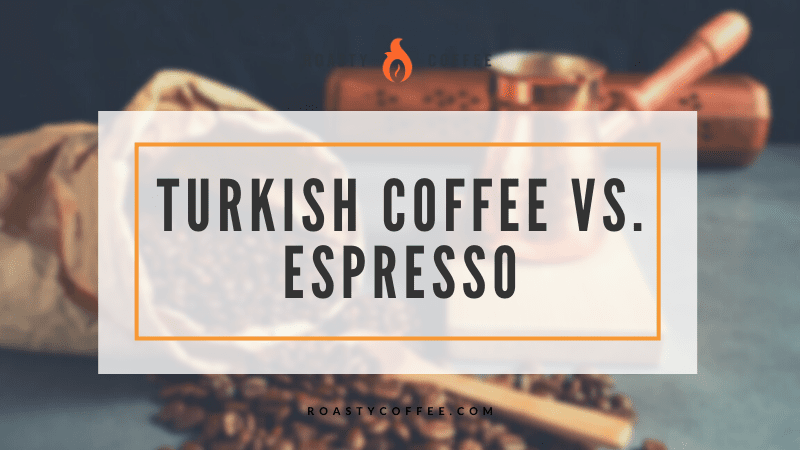When it comes to strong coffee, two coffee traditions immediately come to mind; Turkish coffee vs espresso.
Your average coffee lover often gets confused about the differences between these, though, so let’s talk about what sets each of these drinks apart.

What Is Espresso?
Coffee goes through a long process to get from the plant to your cup, but the preparation methods we use today are fancier than those of the past.
Espresso is one of coffee’s oldest preparation methods, featuring finely-ground darker roast coffee that a device forces steam through. The result is a rich, intense coffee flavor profile.
Some people tell me that a pure espresso shot is too strong for them, so they only take it as shots mixed with other coffee. I love all coffee varieties, but I completely understand if people think this strong brew is a bit much.
We mainly use an espresso machine to make espresso these days, and the quality matters. A good machine will prepare noticeably better espresso from any freshly ground beans you add.
What Is Turkish Coffee?
Turkish coffee is a bit of an outlier in coffee preparation methods. Like espresso, it uses finely-ground, roasted coffee beans.
However, This Turkish delight (pun intended) requires a finer grind size than espresso, which already has one of the finest grinds around. It’s hard to grind coffee this fine if you don’t have the right tools, so you might need to buy it prepackaged.
Once you have the grounds, you mix them with cold water and sugar in a pot known as a cezve, then boil it on the stove.
Unlike espresso, in Turkish coffee preparation, the coffee grinds remain in the coffee, leading to Turkish coffee’s famously dark and intense flavor. a bit of sugar is widely accepted when drinking Turkish coffee, added to preference when preparing it instead of mixing it in later.
A Turkish brew is traditionally served with foam, which usually requires spooning the foam into the Turkish coffee cup as the drink boils.
Most people drink it along with a glass of water to cleanse the palette.
Which One Is Better?
The Turkish coffee vs. espresso debate is entirely subjective. The best way to determine which one you prefer is to try both, preferably one right after the other, to get the best comparison.
However, despite their similarities, there are differences between these drinks.
I like Turkish coffee the most because of its intense flavor and tolerance for adding sugar, but I know plenty of people who prefer to down an entire shot of espresso in one go and get straight to work instead of slowly sipping a drink.
Here’s what you should know about the differences between these drinks:
Bean Selection
Turkish coffee usually uses Arabica coffee beans, which hold up well during the grinding process and impart this drink’s distinctively intense flavor.
Espresso also uses arabica most of the time, though some people use robusta beans instead.
The primary difference is that many people use espresso coffee beans specifically to make espresso, while Turkish coffee can work with regular dark-roasted beans.
Espresso beans are roasted to work well with the high-pressure extraction process that espresso machines use, and the difference in flavor is significant if you drink coffee as often as I do.
Brewing Processes
Brewing Turkish coffee takes longer than making a shot of espresso, assuming you have decent equipment. A quality machine can make espresso in about half a minute, though this brewing time will go up if you want to make more than one shot at a time.
Turkish coffee usually takes a few minutes to boil on the stove, plus additional preparation if you’re adding sugar. One of the key differences between these drinks is that Turkish coffee demands you start with cold water when mixing in the grounds and sugar.
This is a westernized process, though. In Turkey, people often use a large, sand-filled pan set above an open fire. This process distributes the heat exceptionally well, and when done correctly, the coffee will rise to the top almost instantly.
From there, you can pour some out and put it back on the sand to heat up again.
Using sand to heat coffee provides several advantages, including adjusting the temperature by moving the coffee pot deeper into the sand. It’s startlingly quick once you get used to it and can make a more authentic brew, though it’s too labor-intensive for a fast morning cup.
Espresso allows you to use already-hot water in a machine, making the coffee brewing process shorter so that you don’t have to spend time waiting for it to boil. The difference is no more than a few minutes by Western preparation methods, but if time is tight, espresso is clearly faster.
Roasting Options
Espresso works best with a dark roast. Roasting is ultimately a matter of preference, but most people prefer dark roasts for espresso for better flavor and consistency.
A proper espresso roast usually goes for a little longer and a little hotter than other beans, which helps decrease acidity and improve the overall flavor.
Turkish coffee works well with any roast. Some people recommend starting with a medium roast because the beans will char a little more during boiling. Others even start with a light roast.
Turkish coffee is strong enough to magnify any flavor, so I suggest using a lighter roast for your first cup, then getting progressively darker until you find your favorite flavor.
Grinding Process
The grinding process is another major difference between espresso and Turkish coffee.
Espresso usually uses grounds about 400 microns thick, or about 5.5 times the width of an average human hair.
This is fine enough to pass steam through coffee grounds and make the drink without the large gaps you’d see in a coarse grind. Espresso is the finest setting the typical coffee grinder offers.
A Turkish grind has a fiber consistency of about 200 microns thick or three times the width of human hair. Grinding coffee this small takes a specialized coffee grinder and makes it much easier for the coffee to mix into the water and produce a high-quality drink.
Notably, espresso still tastes smoother than Turkish coffee. Turkish coffee keeps the coffee grounds inside the drink, creating a slightly gritty and textured drinking experience. Espresso leaves the coffee grounds behind, so it’s smoother overall.
Caffeine Content
Some people drink coffee mainly for the boost of caffeine. Even if that doesn’t apply to you, it’s good to know how much you’re consuming so you can adjust as needed.
The exact amount of caffeine in a drink will depend on factors like what roast you’re using and how slowly or quickly you make your coffee.
Espresso usually has around 63 milligrams of caffeine per fluid ounce, the standard shot size for this drink. This is significantly higher per ounce than regular coffee, although a full eight-ounce cup of coffee will probably have twice as much total caffeine as a shot of espresso.
Turkish coffee has about 25 milligrams of caffeine per fluid ounce, although most people drink at least two ounces at a time. That’s still less than half the caffeine levels a single shot of espresso contains, although, by volume, it’s still more than an equal amount of regular coffee.
Things get closer if you use another brewing method. Many people brew Turkish coffee at double strength, two tablespoons at a time instead of one tablespoon of coffee grounds. This doubles the amount of caffeine, although espresso still wins out in total caffeine amounts.
Overall Flavor
Both Turkish coffee and espresso have intense flavors, meaning you’ll notice the unique profiles of each type of bean. Quality matters for all coffee, but it’s imperative when you’re making a drink bold enough to highlight every flavor note.
That said, Turkish coffee has a more robust flavor overall. It is also a three-step drinking experience, starting with the froth at the top and going through a smooth section, then finishing with a gritty region where the grounds have settled.
Espresso isn’t weak coffee by any stretch of the imagination; it’s just not quite as strong as Turkish coffee. Frankly, I think this is the point where flavor intensity stops mattering as much.
Both are strong enough that you’re only going to enjoy them if you like coffee flavors to start with.
This isn’t a decision between mild and intense flavors—it’s a choice between strong and even stronger. Most people either like how coffee tastes or they don’t, so this isn’t a good metric to use when deciding between Turkish coffee and espresso.
Availability
Espresso is more widely available in coffee shops than Turkish coffee. The preparation time difference isn’t a significant factor because most people are already willing to wait a few minutes for a barista to brew and deliver their coffee.
Smaller coffee houses and specialty stores are more likely to serve Turkish coffee. You may also occasionally see this on restaurant menus. Turkish restaurants near-universally offer their traditional coffee.
Things get easier if you’re preparing the coffee at home. You can buy Turkish coffee grounds in most stores or buy a grinder with the correct settings and do it yourself.
Many coffee shops can also grind beans to Turkish fineness on request so you can take them home, although they may insist that you buy the beans from them before they grind them.
Drinking Experience
This is another subjective area, but I’ll try to explain this well for people who aren’t familiar with coffee.
Espresso is a concentrated coffee preparation. It’s about enhancing the flavor as much as possible in a small drink. It’s quite intense, but since it’s smooth, it’s easy to mix with other liquids, drink as a single shot, or even sip from if you prefer.
In many ways, espresso represents the real flavor of a coffee bean.
Turkish coffee is even more intense than espresso, but it provides a varied drinking experience. That’s the keyword here, too. Turkish coffee truly is an experience to sit down and enjoy at leisure, rather than swallowing it as quickly as possible so you can get back to the grind (pun intended).
You can see the differences between these drinks in their history, which is our final topic.
The Origin of Drinks
Espresso started towards the end of the 1800s when traditional coffee brewing usually took several minutes.
It was a busy time in Europe, and most coffee drinkers wanted to get their drinks and go. It was also the age of steam, and an Italian man named Angelo Moriondo decided to apply steam to people’s beloved drinks and received a patent for it.
By the 1900s, the idea would pass through several more hands to create the commercial espresso machines we know today.
Luigi Bezzera made a large machine to boil water, then reduce it to the right temperature (about 195 Fahrenheit) and push the steam through tamped coffee. However, the machine required an open flame and wasn’t consistent. That’s bad if you want good coffee.
Bezzera eventually talked with Desiderio Pavoni, who bought the patents and improved on the basic design.
They added several safety features and even the steam wand, eventually debuting the complete machine in 1906 in Milan. The resulting drink was too weak to be considered espresso these days, but their creation would eventually become the machines we know today.
In short: Espresso’s history is about speed, consistency, and power for making drinks.
The Origin of Turkish coffee
Contrast this with Turkish coffee, which got its start in the 1500s. Most records suggest that a Turkish governor in what we now call Yemen obtained coffee beans and tried them out, then quickly recommended them to his ruler, Sultan Suleiman the Magnificent.
Suleiman’s staff soon began experimenting with the beans, eventually grinding them in mortars and brewing coffee that way. The elites drank it first as part of a social process, and ultimately, the drink spread to the rest of the empire as more beans became available.
Today, in Turkey, serving coffee is still an essential part of hospitality with a bit of ritual involved. It’s common to brew some for guests as soon as they arrive and to make it to their tastes.
The flavor is intense, but the strong social aspect shows why the experience of drinking Turkish coffee is just as important as the flavor.
Final Thoughts
Espresso and Turkish coffee are both intensely flavorful ways to enjoy coffee.
Espresso focuses on speed and is great if you want some caffeine in a couple of minutes, while Turkish coffee is better enjoyed at a more relaxed pace.
The difference is mainly a matter of preference, so I suggest trying both. You never know when you’ll find a new way of making coffee that you’ll love.
Happy Caffeinating!







